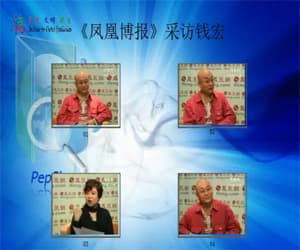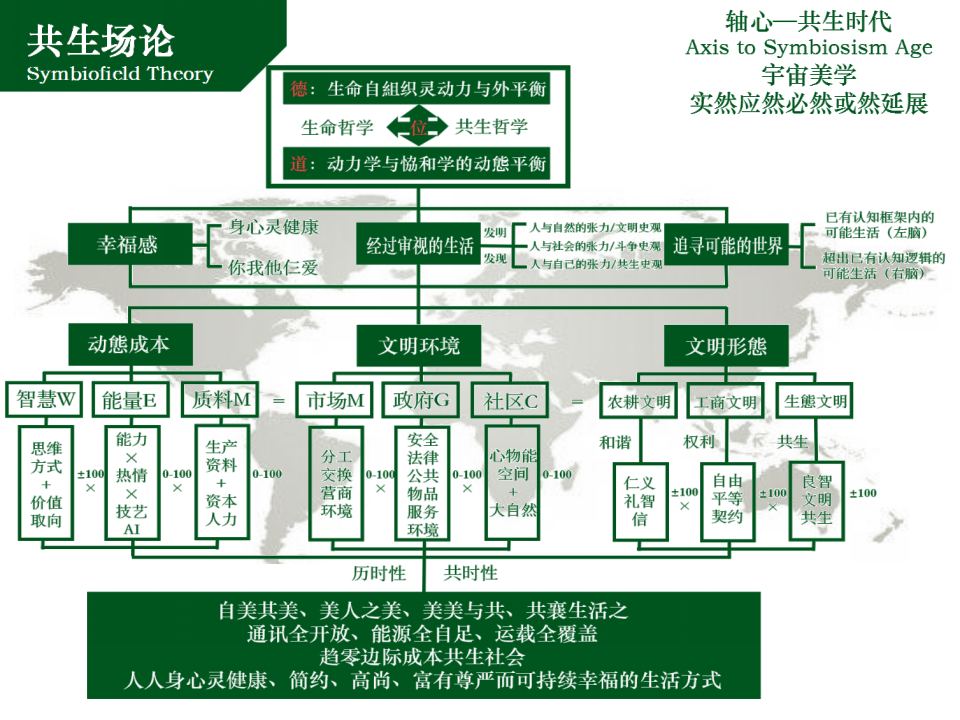New Articles
-
 迈向新世界秩序:以社区生态主权取代地缘政治... 2025/06/23
迈向新世界秩序:以社区生态主权取代地缘政治... 2025/06/23Towards a New World Order: Replacing Geopolitical Sovereignty with Community Ecological Sovereignty迈向新世界秩序...
-
 遣返、消化、改变三大策略并举 2025/06/12
遣返、消化、改变三大策略并举 2025/06/12Deportation, Integration, and Transformation: Three Concurrent Strategies to Address Illegal Immigration 解决“非法移...
-
 川普与马斯克的和解空间 2025/06/08
川普与马斯克的和解空间 2025/06/08川普与马斯克的和解空间 Reconciliation Space Between Trump and Musk ——假如把《大而美法案》改为:Slim and B...
-
 重新定义企业家在文明中的角色 2025/06/03
重新定义企业家在文明中的角色 2025/06/03Redefining the Role of Entrepreneurs in Civilization重新定义企业家在文明中的角色 By Archer Hong Qian &n...
共生思想理论前沿
THE THEORY
-

-

-

-
 关于中文“共生”翻译及对应的人、事、物之说明
关于中文“共生”翻译及对应的人、事、物之说明关于中文“共生”翻译及对应的人、事、物之说明 ——Symbiosism:Charles Thomas Taylor &Qian hong又一次量子缠绕...
查看详细说明
Speech
-
 三大自组织货币的共生格局——宏观世界之数字货币 2021/07/08
三大自组织货币的共生格局——宏观世界之数字货币 2021/07/08三大自组织货币的共生格局 ——宏观世界之数字货币 钱 宏 The Institute for Global Symbiosism(...
-
 新汉字yǜ的释义 2019/11/16
新汉字yǜ的释义 2019/11/16语从金音玉(Yǜ):金口玉言,一诺千金,性人诚恳、执信; &n...
-
 钱宏:中国的真实经验与未来走向(凤凰博报专... 2019/11/16
钱宏:中国的真实经验与未来走向(凤凰博报专... 2019/11/16点击播放 中国的真实经验与未来走向《凤凰博报》专访钱宏主持人:...
The Crux of China’s Economic and Social Structural Problems
发布时间:2021/11/18 公司新闻 浏览次数:547
The Crux of China’s Economic and Social Structural Problems
The structural defects of Yifu Lin’s New Structural Economics (Abstract)
Archer Hong QIAN
President of the Institute for Global Symbiosism(HK)
Executive Summary
This abstract is extracted from the article Practical Strengths and Theoretical Deficiencies of YIfu Lin’s New Structural Economics published on the WeChat public channel Global Symbiosis Forum (IGS1218) in January 2018, two months before the Sino-US “Trade War” began.
Over the past year or so, the key problem of the Sino-US trade war can be summed up in one sentence, that is, both China and the US have structural problems in their respective economies and societies. Therefore, both have ample room for improvement (see Archer Hong Qian: The China model and the US model each have plenty room for improvement — written at the publication of Fukuyama’s Identity and the China Development Summit Special Topic Symposium, people.com.cn and International Daily http://www.chinesetoday.com/zh/article/1244827). But to improve or change, one has to find the crux of its structural problems. Here the crux refers first and foremost to the way of thinking in economics and value orientation.
Common sense tells us that problems caused by a certain way of thinking could not be solved by the same way of thinking. Due to Mr. Yifu Lin’s special political status and influence, there is a certain high degree of correlation between the structural defects of his so-called New Structural Economics (NSE) theory and the structural problems of China’s economy and society. Therefore, when we set out to solve China’s economic and social structural problems, we not only can no longer use the thinking of NSE to solve the problem, but also must sort out the structural defects of Mr. Lin’s NSE.
From the perspective of Symbionomics (symbiotic economics), NSE certainly has its practical merits. However, apart from the “structural omissions” of the NSE, such as geographical “Horizontal country comparative study”, China’s “Regional comparative study, Urban and rural comparative study, and Social strata comparative study”, NSE clearly has six “theoretical deficiencies” in just positioning the relationships between China’s market and the government, economy and politics, foundation and superstructure.
Abbreviations:
NSE: new structural economics
MET: market economy theory

2008年由高尚全先生介绍钱宏与林毅夫相识
The following is the abstract.
The “New Structural Economics (NSE)” negates the country dependence theory of the “old structural economics”, but unconsciously forms its own dependence theory of enterprises and citizens (farmers).
Mr. Yifu Lin, as an independent economist, has the theoretical ambition of establishing “China’s economics” on the basis of “China’s economic miracle”, and has even made valuable efforts to “bring China into the world” in “helping” African countries speak and helping Chinese enterprises “go global”. In particular, he has shown a sincere heart to speak on behalf of “the triple objects of governments, enterprises, and farmers (citizens) “, which is awestruck. However, despite all that, compared with the “Longitudinal country comparative study“, his NSE has obvious theoretical defects in the study of the relationships between China’s “market and government”, “economy and politics” and “foundation and superstructure”, while NSE has obvious structural omissions in “Regional comparative study”, “Geographical and humanistic comparative study” (including “horizontal country comparison”), “Urban and rural comparative study”, especially “Social strata comparative study“.
Leaving aside the four “structural omissions” mentioned above, just speaking of defining the relationships between China ‘s market and government, economy and politics, foundation and superstructure, Lin’s NSE has the following six obvious “theoretical deficiencies”.
First, from the perspective of legal common sense, governments, enterprises and farmers (citizens) are not the “triple object” of economists, but the “triple subject (entity)” with the ability to self-organize and balance outreach, i.e., governments, enterprises and farmers (citizens) all have the economic significance of legal “behavior entity”, or “three self-organizational person”.
Therefore, although Yifu Lin also regards viability of enterprises as the basis of NSE’s micro-analysis, which theoretically transcends the “macro-economics” and “micro-economics” division of the current economy, he failed to establish in legal principle that enterprises are market entities, let alone recognizing the economic entity status of individual citizens (farmers).
Second, philosophically, Marx said, “The first premise of all human history is, of course, the existence of living human individuals”. “Triple entity” only emphasizes the player status of governments, enterprises and farmers (citizens). They are all players because they all have the history-creating “life’s self-organizing vitality and outreach balance” and none is a standing-alone entity. Whether in economic, political, cultural, or social activities, governments, enterprises and farmers (citizens) are all involved in “inter-entity” interactions. From this observation, we define these economic research objects as Three Self-Organization Person, who is an actor of trinity (you, me and him/her/it) persons showing symbiotic growth, and whose behavior pattern shows features of open empowerment as a political self-organizing person, economic self-organizing person and cultural self-organizing person. It is not difficult to understand this fact and definition. We only need to prove it in the “division of labor” theory (Adam Smith), “mutual aid” theory (Kropotkin), “innovation” theory (Schumpeter) and “pencil story” (Krudman).
Third, it is not difficult to find out that China’s “comparative advantage endowment” in Yifu Lin’s NSE has the following three characteristics. First, low cost and high cumulative efficiency, such as “late-development advantage” (the corresponding disadvantages are opportunistic laziness and rule violation), arbitrage actions and thinking (which restrain innovative thinking). The second is the external advantages of low barrier and high return, such as joining WTO as the largest developing country “hitchhiking” + “promise to bicker”. The third is to give full play to the Chinese inherent viral “strategic advantage” (out-of-the-box thinking) and “institutional bullying tort advantage” (officials-as-masters thinking) in the current rules.
Most importantly, as Mr. Lin probably has the sense that “it brings no honor to the victor”, he intentionally or unconsciously only talks about “post-development advantage” (arbitrage thinking) and “strategic advantage” (out-of-the-box thinking), and shelves “external advantage” and ignores “institutional bullying tort advantage” (official-as-masters thinking). Meanwhile, arbitrage thinking and out-of-the-box thinking, are like “Tianji’s way of horse-racing”, which unexpectedly compare one’s own strengths to the weaknesses of others, and are of a typical “evil of cleverness”– dishonest and breaking rules of the game (such as breaking competition-of-equals rule of boxing, wrestling, weightlifting, track and field events in the Olympics Games), while (official-as-master) the-strong-takes-all “master thinking” made the China style “resource monopoly + semi-control & semi-market + demolition” a popular practice. As a result, it theoretically avoids or obscures the unprecedented intensification of the basic contradiction between China’s “huge superstructure and overloaded economic base”.
Fourth, at the present stage of China, does the factor endowment structure match her industries and technologies? Is the superstructure born in the economic base? In other words, are China’s current institutional arrangements and two-track gradual reform, including officials-as-masters, land fiscal policy and land financing, taxation and media, born in China’s current factors (including capital, labor and natural resources) endowment structure and its matching industries and technologies? That is to say, whether the two are suitable for each other, and how will their interactions adapt and change over time?
The 19th CPC National Congress report believes that “the principal contradiction in our society is the contradiction between the growing needs of the people for a better life and the imbalance and inadequate development.” Is this basic contradiction related to the “basic contradiction between the huge superstructure and the overloaded economic base”? Obviously, under the actions of the “basic contradiction”, the only magic tool that governments at all levels and state-owned enterprises could use is kidnapping all resources and people of this land in economy, in politics, and in society and carrying out destructive “comprehensive leverage”. As long as it is for development and GDP growth, China’s officials dare to make Chinese society, environment, state, citizens and their descendants to pay any price, because China’s officials have their unique “three hard principles” + “three advantage endowments” in the world.
The three hard principles are: the first is the so-called “state ownership” of ministries and industries, the second is the GDP performance evaluation criteria, and the third is habitual suppression of society innovation (even suppression of governmental organizational innovation).
The three advantage endowments are: resource asymmetry advantage, information asymmetry advantage, power and responsibility asymmetry advantage. These are the comparative advantages of the Chinese governments (officials), but they also make them fall into the “Xiao He equality law” (see “How to get out of the” mid-transition trap“? , published in Key Economic References issue No. 38, 2018, of The Development Research Center of the State Council).
Therefore, whenever we talk about comparative advantages in China, we must make it clear: whose comparative advantages? Who dominates the structure of factor endowment? Do the comparative advantages of the two-track gradual reform lie in government intervention or in enterprise viability? From the perspective of the two-track gradual reform, if the factor endowment structure only refers to “capital, labor and natural resources and the level of industry and technology”, but does not include the “official-based institutional arrangements for land finance, finance, taxation and media”, then it’s obviously not a complete summary. The importance of this issue involves the assessment of “basic national conditions” or “China characteristics”.
Fifth, therefore, naturally the NSE does not talk about the “superior / inferior nature of backwardness” (see the debate between Xiaokai Yang and Yifu Lin in 2002) and only talks about “the advantages of backwardness”; NSE also does not talk about the “energy efficiency / energy consumption duality of industrial planning” (see the debate between Yifu Lin and Weiying Zhang in 2016), but only “the effectiveness and the necessity of industrial planning” and ignoring the rest.
In today’s world with the emergence of three major limits: the limit of growth, the limit of confrontation, and the limit of manipulated evil-doing, with the strengthening of self-organizing vitality and outreach balance of individual citizens and communities of all countries, and under the conditions of the third globalization wave in the ecological era with inclusive resources allocation (relative to colonial era and free trade era), our strategic thinking of the Emperor Qin and Han Wu style, which re-emphasizes the necessity of conflicts between sovereignty states of developmentalism and demands “sacrifices” from our citizens and societies, is not only outdated, but also violates the common sense that universality resides in particularity, and even loses the goal and direction of “making a bigger GDP cake”.
Sixth, therefore, it is difficult for us to see the NSE to put forward theoretical innovative methods and policy measures in the aspects of “Regional comparative study, Geographical comparative study (including horizontal country comparison), Urban and rural comparative study, especially Social strata comparative study“. Therefore, the NSE generally ignores the resource burden imbalance that every person living in this land who has basic perception and common sense can find out easily– natural burden imbalance, societal burden imbalance, family burden imbalance (health of the body, mind and soul), etc., the empirical fact of broad ecological burden imbalance.
I would like to make it clear that economic theories with these theoretical deficiencies and structural omissions are not only just Yifu Lin’s NSE, but also the structuralism to be introduced by Mr. Yifu Lin, and the “neo-liberalism and the policy prescription of the Washington Consensus” which draws a clear line with NSE, and even include the so-called “Socialist Political Economics of Contemporary China” which is touted as “market economy theory 3.0”.
By the way, in order to explain the “China miracle”, someone divided the “market economy theory (MET)” into three types: 1.0, 2.0 and 3.0 — that is, the traditional liberal economics since Smith and the contemporary neo-liberal economics belong to the MET1.0; and the economics that advocate state intervention represented by Keynes and the earlier Liszt belong to MET2.0; and the Socialist Political Economics of Contemporary China belongs to MET3.0. Furthermore, they believe that MET3.0 is an inheritance and development of MET2.0, and is fundamentally opposed to MET1.0.
At a first glance, this division seems to highlight the economic status of MET 3.0 in the “three-dimensional subject market economy theory”, and it embedded the counter-reactions and even super-active effect of politics, government (state) and superstructure to economy, enterprises and foundation into traditional economics.
However, it cannot solve the worldwide situation of “centurial pendulum cyclical predicament of market freedom and government regulation”, or the situation of “raise prices to eliminate inventory, and increase production to reduce production capacity” and “add flour when water is in excess, and add water when flour is in excess”. On the contrary, it aggravates the trend of “politicization of economy, and economization of politics” and “marginalization of citizens and society” (so called the superiority of “concentrating efforts to do great things” can not only do great good things, but also do great bad things! ), and even leads to the collapse of the “social base” (rural decline and/or urban hollowing out) and “natural revenge”, that is, the reverse problems of “harmonious symbiosis between human beings and nature”.
As long as we do not jump out of the dual economic form of “government economy” and “market economy”, as well as the simple economic thinking of “macroeconomics” and “microeconomics” dichotomy, and do not “let production return to life”– that is, everyone can be healthy, simple, noble, dignified, and can sustainably and happily rehabilitate — contemporary economics can not get out of the embarrassing situation of the “centurial pendulum”. In other words, just as the “purely military viewpoint” at a time in the past could not solve the problems of China’s revolution, today, “pure economics thinking” can not solve the problems of China’s economy to transit from “have it or not” to “good or not” in the views of ecological civilization development.
Based on the above, it remains to be seen whether the NSE has the potential to “clarify the boundary between state intervention and market mechanism in a more general theoretical sense, and provide the basis for more innovative economic ideas”. But I think, regardless of whether NSE has such potential, I do hope that Mr. Yifu Lin’s good wish to “train people who can win the Nobel Prize in economics”– bringing Chinese scholars to the Nobel Prize in economics–will become a reality in the near future, given the platforms of the Institute of New Structural Economics of Peking University and the Research Institute of South-South Cooperation.
Finally, Mr. Yifu Lin’s devotion to Bing Li and his son, who built the Dujiangyan water conservancy project, let me renew my respect. I am also curious that Mr. Lin likes Yangming Wang’s philosophy. Over the past 40 years of reform and opening up, it is widely popularized that knowledge is power, technology is power, management is power, authority is power, and capital is power. Therefore, in recent years, we observed the emergence of “conscience school”, “Yangming boom”, “four-sentence teaching”, “conscience education” and “Yangming College” phenomena, and so we understood.
However, a common sense that everyone knows in his/her heart is that knowledge and technology have no direction, and knowledge and technology are “not printed coins that can be used” (Bacon) and must go through self-organization of individual lives. While management, authority and capital have powers and their own directions, but their directions have a fare greater probability of pointing to evil (manipulation, monopoly) than pointing to justice and appropriateness (justice and balance), or at least have “duality”. This is because that in the sense of social division of labor, knowledge and technology belong to the category of information energy, which have use values of non-exclusive tools; while management, authority and capital belong to the category of material energy and are exclusive tools, so that they have a value propensity.
In contemporary China, we see the prevail of all kinds of “Science of Success” based on “Unity of Knowledge and Action” and “Integration of Knowledge and Practice“. But what if these sciences are “immoral” or “improper”? This is also the primary problem that Adam Smith faced when he published The Theory of Moral Sentiments in 1759, which is why he published The Wealth of Nations nervously as late as 15 years later. (in Fudan Campus, on January 26, 2018)
I have always firmly believed that the Sino-US trade delegation has the wisdom to reach trade agreements aimed at promoting structural changes. In this way, the above combing work may open up ideas for solving China’s economic and social structural problems.
Shenzhen Langhu Hotel on May 3, 2019.
Translator: Yadi Tan
E-mail: qh2012@vip.126.com
Mobile :+1 236 558 7628 or +86 13818181587
中国经济社会结构性问题之结症
——林毅夫“新结构经济学”的结构性缺陷(摘要)
錢 宏
(全球共生研究院)
本摘要,摘自中美“贸易战”开打前两个月的2018年1月,发表在 “全球共生论坛”公众号(IGS1218)上的《林毅夫新结构经济学的现实长项与理论缺失》。
一年多来,中美贸易战的结症,可用一句话来概括,就是中美经济社会各自都有结构性问题。因此,都存在很大改进空间(参看钱宏:《中国模式与美国模式各自大有改进空间——写于福山《身份》将问世与中国发展高层论坛专题研讨会之际》,人民网《国际日报》http://www.chinesetoday.com/zh/article/1244827),而要改进,甚至改变,就要找到各自结构性问题的结症所在。这里讲的结症,首先是指经济学思维方式与价值取向。
常识告诉我们,不能用跟造成问题的思维方式相同的思维方式解决问题。由于林毅夫先生的特殊政治地位及其影响力,他所谓“新结构经济学”理论上存在的结构性缺陷,与中国经济社会的结构性问题之间,在很大程度上存在着某些对应关系。因而,当我们开始着手解决中国经济社会结构性问题时,不但不能再沿用新结构经济学的思维方式解决问题,而且,必须对林先生经济学的结构性缺陷进行梳理。
以Symbionomics(共生經濟学)观之,新结构经济学当然也有其现实优长,然而,撇开新结构经济学的地域性“横向国别比较研究”、中国“区域比较研究”、城乡市农比较研究、社会阶层比较研究这些“结构遗漏”不讲,单就中国市场与政府、经济与政治、基础与上层建筑的关系定位而言,新结构经济学尚明显带有六大“理论缺失”。
2008年由高尚全先生介绍钱宏与林毅夫相识
以下为摘要内容:
“新结构经济学”否定了“旧结构经济学”的国别依附理论,却又不自觉地形成了自己的企业、公民(农民)依附理论。
所以,相对于“纵向国别比较研究”而言,尽管林毅夫先生作为独立经济学家,有着以“中国经济奇迹”为宏观分析基础,建立“中国经济学”的理论抱负,甚至在“帮”非洲国家说话和助力中国企业“走出去”方面,做出了“把中国带入世界”的宝贵努力,特别是同时也有“帮”“政府、企业、农民(公民)三重客体”说话的拳拳之心,让人肃然起敬!但是,他的“新结构经济学”,在中国国内的“市场与政府”、“经济与政治”、“基础与上层建筑”的关系研究方面,有着明显的理论缺陷,而在“区域比较研究”、“地理人文性地域比较研究”(含“横向国别比较”)、“城乡市农比较研究”,特别是“社会阶层比较研究”上,则有着明显的结构性遗漏。
撇开地域性“横向国别比较研究”、中国“区域比较研究”、城乡市农比较研究、社会阶层比较这些“结构遗漏”不讲,单就中国市场与政府、经济与政治、基础与上层建筑的关系定位而言,新结构经济学尚明显带有下列“理论缺失”:
第一,从法理常识上看,政府、企业、农民(公民)并非经济学家的“三重客体”,而是具有“自组织力与外连接平衡能力”的“三重主体”,即政府、企业、农民(公民)都具有法理“行为主体”即“仨自组织人”的经济学意义。所以,尽管林毅夫也把“企业自生能力作为新结构经济学微观分析基础”,但其在理论上超越现行经济的“宏经”与“微经”划分,未能在法理上确立企业的市场主体地位,更没有承认公民(农民)个人的经济主体地位。
第二,从哲学上看,马克思说,任何历史的第一个前提,是“有生命的个人”的存在。“三重主体”只是强调政府、企业、农民(公民)的主体地位,之所以都有主体地位,是因为政府、企业、农民(公民)都具有创造历史的“生命自组织内生性活力与外连接平衡能力”而又非独存的主体。无论在经济活动,还是在政治活动、文化活动、社会活动中,政府、企业、农民(公民)都是一种“主体间性”的相互作用共襄生活的过程。由此观察,我们对经济学研究对象,给出仨自组织人的定义,仨自组织人(Three Self-Organization Person),即行为方式上同时具有开放赋能(Open empowerment)的政治自组织人、经济自组织人、文化自组织人三位一体全人称(你我他)共襄生长特征的行为主体。理解这一事实和定义并不难,我们甚至只需在“分工”理论(亚当·斯密)、“互助”理论(克鲁泡特金)、“创新”理论(熊彼得)和“铅笔的故事”(克鲁德曼)中就能加以证实。
第三,这样一来,不难发现林毅夫“新结构经济学”所讲的国别“比较优势禀赋”有这样三个特征:一是成本低、积效高,如“后发展优势”(对应其劣势,是投机取巧偷懒带来惰性和违法),套利行为和思维方式(抑制创新思维);二是低门槛、高回报的外部性优势,如以最大发展中国家身份加入WTO“搭便车”+“承诺扯皮”;三是在现行规则中发挥中国人固有的病毒性“谋略优势”(逾矩思维)和“体制性欺弱侵权优势”(官本位主体思维)。
最重要的是,大概因为林先生知晓“胜之不武”的道理,他有意无意地只讲“后发展优势”(套利思维)和“谋略优势”(逾矩思维),搁置“外部性优势”和忽略“体制性欺弱侵权优势”(官本位主体思维)。而套利思维、逾矩思维,如“田忌赛马”,出其不意地拿自己的长项比别人的弱项,属于典型的“聪明之恶”——不守诚信、破坏游戏规则(如破坏奥运会拳击、摔跤、举重、田径等项目对等比赛规则),而(官本位)强者通吃的主体思维,导致中国式“资源垄断+半管制半市场+强拆”大行其道。结果在理论上回避或遮盖了中国“庞大上层建筑与超负荷经济基础基本矛盾”空前激化这一事实真相。
第四,中国社会现阶段,要素禀赋结构是否与产业和技术对应?其上层建筑是否内生于经济基础?或者说,中国现行包括官本位的土地财政、土地金融、税收、媒介制度安排及其双轨渐进改革,是否内生于与中国现行包括资本、劳动和自然资源等要素禀赋结构及其对应的产业和技术?也就是两者之间是否相适应以及相互作用、随时间变化的结果情况如何?19大报告认为“我国社会的主要矛盾是人民日益增长的美好生活需要和不平衡不充分发展之间的矛盾”,这一主要矛盾背后,是否与“庞大上层建筑与超负荷经济基础之间的基本矛盾”有关?很显然,在“基本矛盾”作用下,各级政府及国企唯一可能用得上的法宝,就是在经济、政治、社会上对这片国土、人民等一切资源实行绑架性和毁灭性的“全面负债经营”。只要是为了发展,为了GDP增长,中国官员就敢于让中国社会、环境、国家、国民及其子孙付任何代价,因为,中国官员拥有世界独一无二的“三个硬道理”+“三大优势禀赋”。三个硬道理是:第一个是部门、行业所属的所谓“国有制”,第二个是GDP政绩考核标准,第三是习惯性抑制社会组织创新(甚至抑制政府组织创新);三大优势禀赋是:资源不对称优势、信息不对称优势、权责不对称优势。这既是中国政府(官员)的比较优势,也使其陷入“萧何等式定律”(参看《如何走出“转型中期陷阱”?》,刊国务院发展研究中心《经济要参》2018年第38期)。所以,凡在中国讲比较优势,都必须弄清是:谁的比较优势?谁主导了要素禀赋结构方式?双轨渐进式改革的比较优势,是政府干预力,还是企业自生能力?从双轨渐进改革看,要素禀赋结构,如果仅仅是指“资本、劳动和自然资源及产业、技术水平”,而不包括“官本位的土地财政、金融、税收、媒介制度安排”,那么显然是不完全概括。而这个问题的重要性,涉及“基本国情”或“中国特色”的评估。
第五,因此,新结构经济学自然也就不讲“后发优/劣二重性”(参看杨小凯与林毅夫2002辩论),而只讲“后发优势”,也不讲“产业规划能效/能耗二重性”(参看林毅夫与张维迎2016辩论),而只讲“产业规划的有效性必要性”,而不及其余。这在当今世界出现“增长的极限、对抗的极限、操控施恶的极限”三大极限,而各国公民个体和共同体生命自组织内生性活力与外连接平衡能力日益强化,普惠配置资源生态化时代(相对殖民时代、自由贸易时代)的第三次全球化浪潮条件下,重新强调发展主义的主权国别斗争必要性,从而让本国公民、社会作“牺牲”的秦皇汉武式谋略思维,不仅不合时宜,而且违背了普遍寓于特殊之中的常理,更失去“作大GDP蛋糕”的目标和方向。
第六,于是,我们也就很难看到“新结构经济学”在“区域比较研究、地域比较研究(含横向国别比较)、城乡市农比较研究,特别是社会阶层比较研究”方面,提出富有理论创新的方法和政策措施。因而,在“新结构经济学”中,也就整体上忽略了这片土地上每个有基本感知能力和常识的人,都很容易发现的资源性背负失衡——自然背负失衡、社会背负失衡、家庭背负失衡(身心灵亚健康)等——广义生态背负失衡这一经验事实。
我想说明一下,具有这些理论缺失和结构性遗漏的经济学理论,远不只是林毅夫的“新结构经济学”,也包括林毅夫先生要引入的结构主义,以及与之划清界限的“新自由主义思想与‘华盛顿共识’政策药方”,甚至包括以“市场经济理论3.0”相标榜的所谓“当代中国社会主义政治经济学”。
顺便说一句,有人为了解释“中国奇迹”,将“市场经济理论”划分为1.0、2.0、3.0三个类型——即:从斯密以来的传统自由主义经济学,以及当代新自由主义经济学,属于市场经济理论的1.0;以凯恩斯、以及更早的李斯特为代表的提倡国家干预的经济学,属于市场经济2.0;当代中国社会主义政治经济学,属于市场经济3.0——并且认为,市场经济理论3.0是对2.0的继承和发展,并与市场经济理论1.0根本对立。
乍一看,这种划分,似乎突出了市场经济3.0在“三维主体市场经济理论”中的经济学地位,而且,把政治、政府(国家)、上层建筑对经济、企业、基础的反作用乃至超级能动作用嵌入到传统经济学之中。
但是,非但不能解决世界性的“市场自由与政府管制世纪钟摆周期性困境”或“涨价去库存、增产降产能”“水多了加面,面多了加水”的局面,反而会加剧“经济政治化、政治经济化”以及“公民、社会边缘化”趋势(“所谓集中力量办大事”的优越性,既可以办大好事,也可能办大坏事!),乃至“社会底座”坍塌(乡村败落或者城市空心化)和“自然报复”的问题——即反向“人与自然和谐共生”的问题。
只要没有跳出“政府经济”“市场经济”二元经济形态,以及“宏观经济学”“微观经济学”二分法这种单纯经济学思维方式,“让生产回归生活”——即人人健康、简约、高尚、富有尊严而可持续幸福地休养生息——当代经济学,就不能走出“世纪钟摆”的尴尬局面。换句话说,正如当年“单纯军事观点”不能解决中国革命的问题一样,今天,“单纯经济学思维”也不能解决中国经济以生态文明建设观之从“有没有”向“好不好”的转变问题。
基于此,“新结构经济学”有没有“在更一般的理论意义上讲清楚国家干预和市场机制之间的边界,并且可以为更新颖的经济学思路提供基础”的潜力,我们还要拭目以待。但我想,无论“新结构经济学”是否有这样的潜力,我都祝愿林毅夫先生凭借北京大学新结构经济学研究院和南南合作研究院的平台,“培养可以获得诺贝尔经济学奖的人”——把中国学子带入诺贝尔经济学奖——的良好愿望,可望在不远的将来成为现实。
最后,林毅夫先生对建设都江堰的李冰父子的那份虔诚,让我再次肃然起敬。我也对林先生喜欢王阳明哲学,十分好奇。由于改革开放四十年来,知识就是力量,科技就是力量,管理就是力量,权力就是力量,资本就是力量,得到广泛普及,因而近年出现了“良知教”、“阳明热”、“四句教”、“良知教育”、“阳明学院”现象,就可以理解。
但是,谁的心里都知道的一个常识是:知识、科技没有方向,知识、科技也“不是一块印好的硬币,可以拿来就用”(培根),必须经过个体生命自组织。而管理、权力、资本有力量,也有自己的方向,可管理、权力、资本的方向,指向邪恶(操纵、垄断)的概率远远大于指向正当适宜(公义、均衡),至少是具有“两可性”。
这是因为,在社会分工意义上,知识、科技属于信息能量范畴,是非独占性工具使用价值,而管理、权力、资本属于物质能量范畴,是可独占性工具,因而具有价值倾向。当代中国盛行各式各样“知行合一”“知成一体”的“成功学”,然而“缺德”咋办?Impropriety咋办?这也是亚当·斯密1759年发表《道德情操论》时面对的首要问题,正因为如此,他迟至15年后才惴惴不安地发表了《国富论》。(2018年1月26日于复旦望道苑38101A开关居)
我一直坚信,中美贸易代表团,有智慧达成旨在促进结构性改变的贸易协定。如此,以上梳理工作,将可能对解决中国经济社会的结构性问题,打开思路。
公陽子2019年5月3日於深圳羅湖大酒店
上一篇: 为全新经济学的诞生,助产开道!













您好!请登录
已有0评论
购物盒子